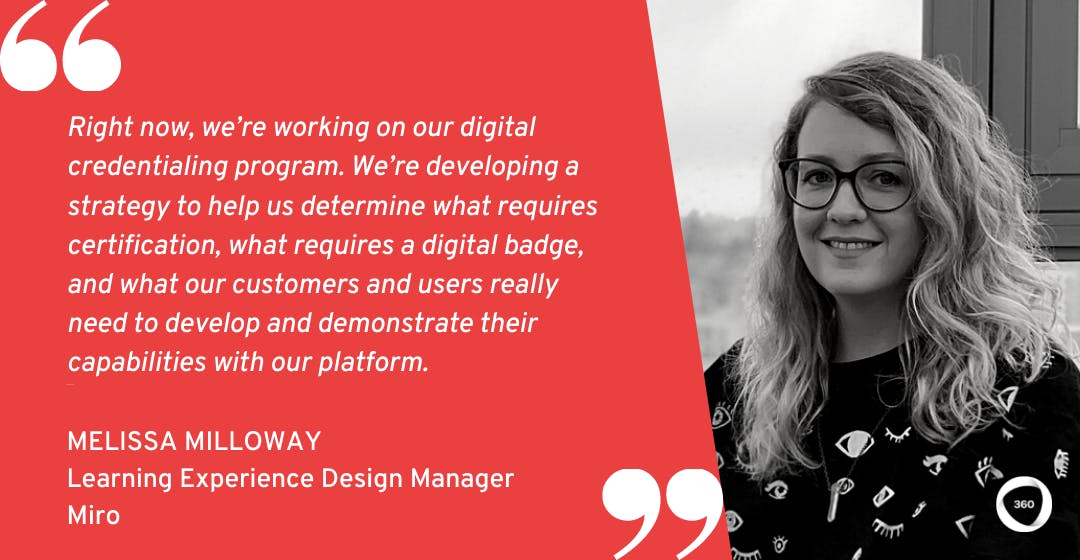It’s never been more important for L&D teams to educate customers and clients in the use and value of your products. Get this right, and you can set your business apart from others in the marketplace by helping people get the very best from what you have to offer.
But how can L&D teams build customer education resources that can adapt as products–and companies–evolve over time? And how can they recognize user achievement in a range of product capabilities and competencies?
It’s always exciting to hear from enthusiastic and talented L&D leaders about new approaches to customer education. That’s why I enjoyed talking with Melissa Milloway, Learning Experience Design Manager at Miro, about her two-step digital credentialing program recognizing a wide range of customer achievement.
Intrigued? Melissa had a great deal of inspiration to share–read on to hear more.
Loving what you’re reading? Come and join the L&D Collective for more great learning insights, resources, and events!
Why digital credentialing is the key to adaptable customer education
Our conversation began with Melissa telling me about how visual collaboration platform Miro approaches learning experience design. Given the company has just raised $400 million in new funding–bringing its total valuation to an incredible $17.5 billion–this will be a crucial area of focus for Miro in the future.
“I lead a team of learning experience designers,” says Melissa. “What we do is think about instructional design, understanding how adults learn, and how to enable and empower them to build skills and apply the skills that they learn.”
“But it is also a mix of the user experience design and seeing how our customers use our products. This focus on customer education is a crucial part of how we improve our products, because it tells us what they need to be able to do their job or build a particular skill.”
Melissa explained that her team leads the Miro Academy, which is where their customers can access a range of asynchronous courses to build their Miro skills. For Melissa, the Miro Academy is a key tool in addressing the company’s biggest training challenge.
“Our biggest challenge is with the pace of product training in general,” she says. “It’s very fast-paced, because products are constantly changing. This makes it tough to keep up with those changes and build for future scalability.”
So, what’s Melissa’s solution to the challenge of customer education with a fast-changing product? As she explains, it’s all about digital credentialing.

“Right now, we’re working on our digital credentialing program. We’re developing a strategy to help us determine what requires certification, what requires a digital badge, and what our customers and users really need to develop and demonstrate their capabilities with our platform.”
Next up, Melissa talked me through her two-step digital credentialing program structure.
Juggling a few growth challenges of your own? Sounds like you need some expert tips from the likes of Amazon, WhatsApp, and Klaviyo on How L&D Can Help Your Company Scale.

You have questions–the experts have the answers
By providing your contact info, you agree to receive communications from 360Learning. You can opt-out at any time. For details, refer to our Privacy Policy.
Miro’s two-step approach to great digital credentialing for customers
As Melissa explains, now is exactly the right time for her and her team to roll out a pilot of Miro’s digital credentialing program.
“There is data out there to show that a digital credentialing program is something warranted and needed,” she says. “For instance, I did a quick look at LinkedIn to establish how often Miro is mentioned in job postings. I found about two thousand job posts mentioning Miro as a skill, or as a tool people should be able to use. I think it’s something that could definitely help someone’s next career move if they have a digital credential from Miro.”
Once Melissa established this need, it was down to her and her team to build the right digital credentialing pilot for Miro’s customers. Here’s a breakdown of her two-step approach.
I found about two thousand job posts mentioning Miro as a skill, or as a tool people should be able to use. I think it’s something that could definitely help someone’s next career.
1. Recognizing a user’s essential product knowledge
As with any great customer education program, Melissa and her team are starting with the basics: recognizing achievements in the ‘Miro Essentials’.
“We have the ‘product feature’ type of badges that recognize a user’s knowledge or skills in the ‘Miro Essentials’,” she says. “These are all the things that you need to get started with Miro. It’s the basics our users need to be able to show their familiarity with the product.”
2. Acknowledging the different ways customers use Miro
Following the basics, Melissa’s digital credentialing program focuses on badges for specialist use cases.
“We’re seeing people use Miro for very different use cases,” she says. “Let’s say you’re a user experience designer. You may use Miro for UX research, and so the way you use it may be very different from someone who is running a program. There might be different types of things people are doing with the platform, depending on their job.”
“That’s why it’s important for our digital credentialing program to acknowledge and recognize these different use cases.”
With Miro’s digital credentialing pilot up and running, Melissa is also considering the need for different levels to reflect what happens when the product changes and course content is updated.
“We’re looking to make sure that our digital credentialing program can flex with the changes and remain as up-to-date as possible.”
Miro’s two-step digital credentialing program is a great way for customers and users to access the most up-to-date training on Miro’s platform. This focus on keeping courses current and fit-for-purpose is a key part of Collaborative Learning, especially using social interactions to highlight outdated or inaccurate information.
Related: Reactions: Deliver Engaging and Up-to-Date Courses with Collaborative Learning
We’re looking to make sure that our digital credentialing program can flex with the changes and remain as up-to-date as possible.
How is Miro measuring the success of its digital credentialing program for customers?
So, that’s an overview of Melissa’s two-step approach to digital credentialing for customers and users. But how can she and her team know they’re making a positive impact?
According to Melissa, there are two key metrics she and her team are hoping to track to demonstrate the impact of Miro’s digital credentialing program: user feedback and acceptance rates
1. Gathering user feedback
“First, we want to gather user feedback and understand the way people would be awarded a particular credential. For example, with Miro Essentials, after they complete the course, our participants go through a quiz to demonstrate what they’ve learned.”
And as she explains, this quiz isn’t a walk in the park. “We need to make sure that the quiz has enough rigor to really demonstrate what the user knows. If any of the questions seem hard, are they hard because it’s worded in a confusing way? Or is it because there’s something that we didn’t really touch on in the course?”
2. Tracking badge acceptance rates
“Second, we need to see how people are reacting to the program. Are we seeing people share their badges afterwards? We’re looking hard at the acceptance rates for our badges. We’re asking if these acceptance rates are where we want them to be, and then going back to the users and trying to understand what’s working well and what could be improved.”
Related: 3 Data-Based Ways to Prove Training ROI (+ Free Training ROI Calculator)
We’re asking if these acceptance rates are where we want them to be, and then going back to the users and trying to understand what’s working well and what could be improved.
Giving users and customers the tools they need to excel
As Melissa says, when it comes down to it, Miro’s digital credentialing program is all about the customer experience, and giving Miro’s users the tools they need to excel.
“Going into the program, my manager had done a lot of interviews with users trying to understand what their needs are, and what they’d be looking for in a digital credential. When a user achieves a credential, there’s a survey that gets served up to you right away, which helps us to understand these needs a lot better.”
“I also plan to do user interviews one-on-one afterwards looking at a variety of different people: folks who are in different careers, as well as folks who are in different stages of their careers. We’re really trying to look at how we can continuously improve upon this, because it’s something that will be a living, breathing program.”
We’re really trying to look at how we can continuously improve upon this, because it’s something that will be a living, breathing program.
I’d like to thank Melissa again for taking the time to share her vision and knowledge with us!
If you’re looking for more expert insights on what makes for a great customer education program, check out our interviews with Sebastian Skarbek of Greenhouse Software on the role of collaboration in customer education, and with Heidi Kirby of Datatrak International on her four-step playbook for great customer learning experiences.
Want more peer insights on transforming workplace learning? Sign up to become a member of the L&D Collective, and check out our other #CLOConnect interviews with top L&D leaders on driving growth and scaling culture through Collaborative Learning. Or you can subscribe (below 👇) to our weekly newsletter to receive our latest posts directly in your inbox.


